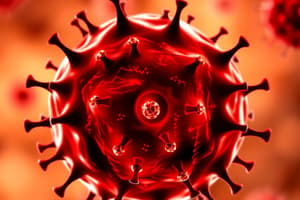Podcast
Questions and Answers
What immunological process is activated when the body mistakenly identifies a substance like pollen as harmful?
What immunological process is activated when the body mistakenly identifies a substance like pollen as harmful?
- Type 3 hypersensitivity reaction
- IgE antibody production (correct)
- Rh incompatibility reaction
- Hemolytic transfusion reaction
Which of the subsequent reactions do not involve red blood cells?
Which of the subsequent reactions do not involve red blood cells?
- Hemolytic transfusion reactions
- Poison ivy reactions (correct)
- Rh incompatibility transfusion reactions
- Autoimmune reactions
What is the role of mast cells and basophils in allergic reactions?
What is the role of mast cells and basophils in allergic reactions?
- They release antibodies to mark the allergen for destruction by other immune cells.
- They directly attack the allergen, neutralizing its harmful effects.
- They bind to IgE antibodies and release substances that cause inflammation and itching. (correct)
- They initiate the production of red blood cells to combat the allergen.
Which condition is least associated with immune complexes building up in the body?
Which condition is least associated with immune complexes building up in the body?
What characterizes chronic lesions that resemble atopic dermatitis?
What characterizes chronic lesions that resemble atopic dermatitis?
Which function of immunity involves the removal of damaged cellular substances to maintain uniformity among cell types?
Which function of immunity involves the removal of damaged cellular substances to maintain uniformity among cell types?
Which type of immunity is present at birth and involves a nonspecific response?
Which type of immunity is present at birth and involves a nonspecific response?
What is the mechanism of natural passive acquired immunity?
What is the mechanism of natural passive acquired immunity?
An immune system that overreacts against its own tissues is an example of what?
An immune system that overreacts against its own tissues is an example of what?
What characterizes artificial active acquired immunity?
What characterizes artificial active acquired immunity?
Which of the following describes the surveillance function of a normal immune response?
Which of the following describes the surveillance function of a normal immune response?
What happens to the immune system when immunocompetence occurs?
What happens to the immune system when immunocompetence occurs?
Which type of hypersensitivity response occurs when the body reacts against self-antigens?
Which type of hypersensitivity response occurs when the body reacts against self-antigens?
IgE antibodies cause the body to recognize which of the following during subsequent exposure?
IgE antibodies cause the body to recognize which of the following during subsequent exposure?
Which of the following is a primary function of mast cells and basophils when triggered by allergens?
Which of the following is a primary function of mast cells and basophils when triggered by allergens?
What is the direct consequence of the immune system attacking mismatched blood cells?
What is the direct consequence of the immune system attacking mismatched blood cells?
Which of the following is the crucial difference between atopic and contact dermatitis?
Which of the following is the crucial difference between atopic and contact dermatitis?
In the context of allergic reactions, what is the role of histamine?
In the context of allergic reactions, what is the role of histamine?
Where are mast cells and basophils typically found in the body?
Where are mast cells and basophils typically found in the body?
What immunological event occurs during the 'Subsequent Exposure' phase of an allergic reaction?
What immunological event occurs during the 'Subsequent Exposure' phase of an allergic reaction?
What is the initial step in a hemolytic reaction when the body encounters a mismatched blood type?
What is the initial step in a hemolytic reaction when the body encounters a mismatched blood type?
In Type I hypersensitivity reactions, which laboratory result is most likely?
In Type I hypersensitivity reactions, which laboratory result is most likely?
A patient is undergoing allergy skin testing. Which assessment finding would be a contraindication to performing the skin test?
A patient is undergoing allergy skin testing. Which assessment finding would be a contraindication to performing the skin test?
Following an intradermal skin test, a patient develops a severe reaction. Which immediate nursing intervention is most appropriate?
Following an intradermal skin test, a patient develops a severe reaction. Which immediate nursing intervention is most appropriate?
A patient experiencing anaphylaxis is prescribed epinephrine. Which route of administration is most appropriate?
A patient experiencing anaphylaxis is prescribed epinephrine. Which route of administration is most appropriate?
A patient with anaphylaxis is receiving epinephrine. Which of the following adverse effects should the nurse monitor for?
A patient with anaphylaxis is receiving epinephrine. Which of the following adverse effects should the nurse monitor for?
A patient is prescribed an antihistamine for allergic rhinitis. What information should the nurse include when educating the patient about this medication?
A patient is prescribed an antihistamine for allergic rhinitis. What information should the nurse include when educating the patient about this medication?
What is the primary purpose of obtaining sputum and nasal/bronchial secretions for testing in the context of allergic disorders?
What is the primary purpose of obtaining sputum and nasal/bronchial secretions for testing in the context of allergic disorders?
A complete blood count (CBC) with WBC differential is ordered as part of diagnostic studies for allergic disorders. What specific information from this test is most relevant in identifying an allergic response?
A complete blood count (CBC) with WBC differential is ordered as part of diagnostic studies for allergic disorders. What specific information from this test is most relevant in identifying an allergic response?
Which medication is most effective for alleviating the signs and symptoms of allergic rhinitis?
Which medication is most effective for alleviating the signs and symptoms of allergic rhinitis?
A patient with allergic rhinitis is prescribed cromolyn. What is the primary mechanism of action of this drug?
A patient with allergic rhinitis is prescribed cromolyn. What is the primary mechanism of action of this drug?
In which of the following scenarios is immunotherapy most definitively indicated?
In which of the following scenarios is immunotherapy most definitively indicated?
What is a known potential adverse effect of immunotherapy in patients with allergic disorders?
What is a known potential adverse effect of immunotherapy in patients with allergic disorders?
A patient with a known latex allergy experiences an allergic reaction after consuming certain foods. What is this phenomenon known as?
A patient with a known latex allergy experiences an allergic reaction after consuming certain foods. What is this phenomenon known as?
Which of the following is the recommended first-line treatment for multiple chemical sensitivity (MCS)?
Which of the following is the recommended first-line treatment for multiple chemical sensitivity (MCS)?
What is the primary consideration when matching organ transplant recipients with available donors?
What is the primary consideration when matching organ transplant recipients with available donors?
During tissue typing for organ transplantation, which factor is NOT essential for compatibility between donor and recipient?
During tissue typing for organ transplantation, which factor is NOT essential for compatibility between donor and recipient?
What is the primary mechanism of action for calcineurin inhibitors like tacrolimus and cyclosporine in preventing organ rejection?
What is the primary mechanism of action for calcineurin inhibitors like tacrolimus and cyclosporine in preventing organ rejection?
Why is the consumption of grapefruit or grapefruit juice a concern for patients taking tacrolimus or cyclosporine?
Why is the consumption of grapefruit or grapefruit juice a concern for patients taking tacrolimus or cyclosporine?
Which of the following best describes the role of calcineurin inhibitors in immunosuppressive regimens?
Which of the following best describes the role of calcineurin inhibitors in immunosuppressive regimens?
Besides corticosteroids, which other medication is commonly used in combination with calcineurin inhibitors like tacrolimus?
Besides corticosteroids, which other medication is commonly used in combination with calcineurin inhibitors like tacrolimus?
Which of the following is NOT a typical component of a standard immunosuppression regimen that includes a calcineurin inhibitor?
Which of the following is NOT a typical component of a standard immunosuppression regimen that includes a calcineurin inhibitor?
A patient taking tacrolimus regularly consumes grapefruit juice. What is the most appropriate immediate action a healthcare provider should take?
A patient taking tacrolimus regularly consumes grapefruit juice. What is the most appropriate immediate action a healthcare provider should take?
Why are calcineurin inhibitors considered a 'foundation' of immunosuppression regimens?
Why are calcineurin inhibitors considered a 'foundation' of immunosuppression regimens?
Which of the following statements accurately describes the clinical use of tacrolimus?
Which of the following statements accurately describes the clinical use of tacrolimus?
Flashcards
Poison Ivy
Poison Ivy
A plant that can cause allergic skin reactions upon contact.
Type 3 Reactions
Type 3 Reactions
Immune responses involving the formation of immune complexes that can cause damage.
IgE Antibody
IgE Antibody
A specific antibody produced during an allergic response that binds to allergens.
Mast Cells
Mast Cells
Signup and view all the flashcards
Basophils
Basophils
Signup and view all the flashcards
Immunity
Immunity
Signup and view all the flashcards
Defense in Immunity
Defense in Immunity
Signup and view all the flashcards
Homeostasis in Immunity
Homeostasis in Immunity
Signup and view all the flashcards
Surveillance in Immunity
Surveillance in Immunity
Signup and view all the flashcards
Innate Immunity
Innate Immunity
Signup and view all the flashcards
Acquired Immunity
Acquired Immunity
Signup and view all the flashcards
Hypersensitivity
Hypersensitivity
Signup and view all the flashcards
Autoimmune Disease
Autoimmune Disease
Signup and view all the flashcards
CBC with WBC differential
CBC with WBC differential
Signup and view all the flashcards
T-cell and B-cell quantification
T-cell and B-cell quantification
Signup and view all the flashcards
Eosinophil count
Eosinophil count
Signup and view all the flashcards
Serum IgE level
Serum IgE level
Signup and view all the flashcards
Skin testing
Skin testing
Signup and view all the flashcards
Anaphylaxis management
Anaphylaxis management
Signup and view all the flashcards
Epinephrine in anaphylaxis
Epinephrine in anaphylaxis
Signup and view all the flashcards
Antihistamines
Antihistamines
Signup and view all the flashcards
Corticosteroids
Corticosteroids
Signup and view all the flashcards
Mast Cell-Stabilizing Drugs
Mast Cell-Stabilizing Drugs
Signup and view all the flashcards
Immunotherapy
Immunotherapy
Signup and view all the flashcards
Latex Food Syndrome
Latex Food Syndrome
Signup and view all the flashcards
Multiple Chemical Sensitivity (MCS)
Multiple Chemical Sensitivity (MCS)
Signup and view all the flashcards
S/S of Multiple Chemical Sensitivity
S/S of Multiple Chemical Sensitivity
Signup and view all the flashcards
Psychotherapy for MCS
Psychotherapy for MCS
Signup and view all the flashcards
Tissue Typing in Transplantation
Tissue Typing in Transplantation
Signup and view all the flashcards
Blood Type Mismatch
Blood Type Mismatch
Signup and view all the flashcards
Subsequent Exposure
Subsequent Exposure
Signup and view all the flashcards
Atopic Dermatitis
Atopic Dermatitis
Signup and view all the flashcards
Contact Dermatitis
Contact Dermatitis
Signup and view all the flashcards
IgE Antibodies Function
IgE Antibodies Function
Signup and view all the flashcards
Hemolytic Reaction
Hemolytic Reaction
Signup and view all the flashcards
Mast Cell Role
Mast Cell Role
Signup and view all the flashcards
Basophil Action
Basophil Action
Signup and view all the flashcards
Calcineurin Inhibitors
Calcineurin Inhibitors
Signup and view all the flashcards
Tacrolimus
Tacrolimus
Signup and view all the flashcards
Cyclosporin
Cyclosporin
Signup and view all the flashcards
Immunosuppressive Regimens
Immunosuppressive Regimens
Signup and view all the flashcards
Mycophenolate Mofetil
Mycophenolate Mofetil
Signup and view all the flashcards
Sirolimus
Sirolimus
Signup and view all the flashcards
Grapefruit Interaction
Grapefruit Interaction
Signup and view all the flashcards
Study Notes
Normal Immune Response
-
Immunity is the body's ability to resist disease
-
Three main functions of immunity:
- Defense: Protects against pathogens and foreign invaders
- Homeostasis: Removes damaged cells and substances
- Surveillance: Identifies and destroys mutated cells
-
Two types of immunity:
- Innate: Present at birth, non-specific, responds quickly to pathogens without prior exposure
- Acquired: Developed over time, specific, requires prior exposure to a pathogen
Types of Acquired Immunity
- Active:
- Natural: Acquiring immunity through infection (e.g., chicken pox)
- Artificial: Acquiring immunity through vaccination (e.g., chicken pox vaccine)
- Passive:
- Natural: Transfer of antibodies from mother to child through placenta or breast milk
- Artificial: Injection of antibodies from another individual (e.g., serum injections)
Altered Immune Response
-
Immunocompetence: The body's immune system's ability to identify, inactivate, and destroy foreign substances. Problems with this create severe infections, cancers, and immunodeficiency
-
Hypersensitivity Reactions: The immune system overreacts and can destroy its own tissues
- Four types:
- Type I (IgE-mediated): Allergies (e.g., hay fever)
- Type II (Cytotoxic/Cytolytic): Antibodies directly attacking cells
- Type III (Immune Complex): Antibody-antigen complexes damaging tissues
- Type IV (Delayed): Delayed response (e.g., contact dermatitis)
- Four types:
Additional Information
-
ABO Incompatibility: Blood transfusion reaction where the recipient's immune system attacks foreign blood cells
-
Rh Incompatibility: Blood transfusion reaction with incompatibility regarding the Rh factor
-
Hemolytic Transfusion Reaction: When the immune system destroys red blood cells from a transfusion
-
Blood Type Mismatch: When the recipient and donor blood types are not compatible
- Immune system attacks foreign blood cells
-
Allergic Reactions:
- Anaphylaxis: Severe allergic reaction, potentially life-threatening
- Atopic Reactions: Inherited tendency to become allergic to environmental allergens
-
Immunotherapy: Treatments that help train the immune system to tolerance an allergen
-
Multiple Chemical Sensitivity (MCS): A controversial disorder characterized by various symptoms purportedly caused by low levels of chemicals
-
Immunosuppressive Therapy: Drugs that reduce the immune response to prevent organ rejection after transplant
-
Graft-versus-Host Disease (GVHD): Potential immune response against the transplanted organ, especially in bone marrow or stem cell transplants
-
Diagnostic Studies: Procedures like complete blood counts, skin tests, blood tests used to diagnose immune disorders/reactions.
Studying That Suits You
Use AI to generate personalized quizzes and flashcards to suit your learning preferences.




